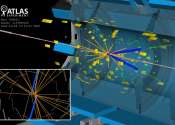ATLAS probes uncharted territory with LHC Run 3 data
Despite its immense success in describing the fundamental building blocks of matter and their interactions, the Standard Model of particle physics is known to be incomplete. Experiments around the globe and in space are therefore ...









